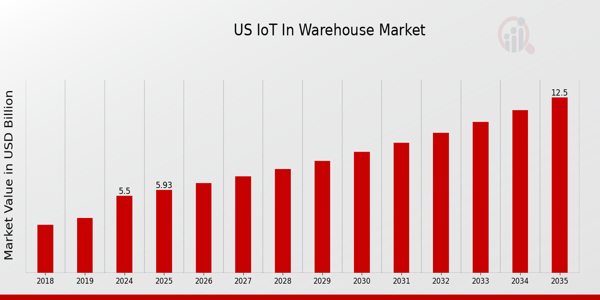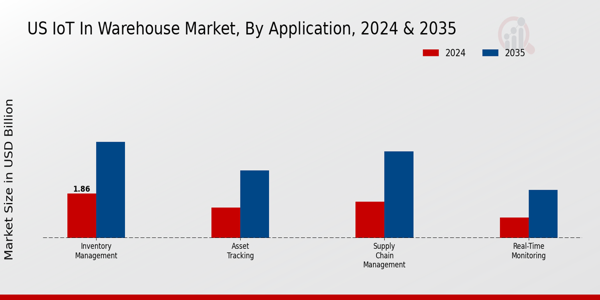US IoT in Warehouse Market Overview
As per MRFR analysis, the US IoT in Warehouse Market Size was estimated at 4.91 (USD Billion) in 2023.The US IoT in Warehouse Market Industry is expected to grow from 5.5(USD Billion) in 2024 to 12.5 (USD Billion) by 2035. The US IoT in Warehouse Market CAGR (growth rate) is expected to be around 7.749% during the forecast period (2025 - 2035)
Key US IoT in Warehouse Market Trends Highlighted
The demand for automation and efficiency in supply chain operations is driving significant trends in the US IoT in Warehouse Market. The necessity of real-time inventory management and monitoring is one of the primary market drivers, as it is becoming increasingly important for businesses to reduce operational costs and improve productivity. Organizations are implementing IoT solutions to optimize their warehouse operations, thereby enabling the efficient collection of data and connectivity. The integration of IoT technologies with existing systems is essential for competitive advantage in the logistics sector, as it supports predictive analytics and enhances decision-making processes.
In the context of these drivers, there are numerous opportunities for businesses in the United States to capitalize on advanced technologies, including artificial intelligence and robotics, in conjunction with IoT solutions. It is anticipated that US warehouses will investigate innovations that can accommodate the heightened demand and expedite order fulfillment as e-commerce continues to expand. The emergence of smart warehouses that are outfitted with IoT sensors presents a substantial opportunity for enhanced safety and efficiency, which numerous companies intend to capitalize on in the years ahead. In warehouse operations, there has been a recent trend toward sustainability. Companies in the United States are increasingly seeking IoT technologies that can assist in the reduction of energy consumption and pollution due to the growing awareness of environmental issues.
Smart energy management systems that are powered by IoT are gaining popularity, enabling companies to monitor and optimize energy usage in real-time. Additionally, the necessity of adhering to safety standards and regulatory compliance has encouraged organizations to allocate resources to IoT solutions that optimize workplace efficiency and safety. Consequently, the US market is poised for transformation and is expected to become more dynamic as the connection between IoT and warehouse operations is likely to be strengthened.

Source: Primary Research, Secondary Research, MRFR Database and Analyst Review
US IoT in Warehouse Market Drivers
Rising Demand for Automation in Warehousing
The increasing demand for automation in warehousing is a significant driver of the US IoT in Warehouse Market Industry. According to the US Bureau of Labor Statistics, the manufacturing and logistics sectors reported a 25% increase in productivity due to automated systems over the past five years. Major organizations such as Amazon and Walmart are heavily investing in the automation of their warehouses, implementing IoT technologies to streamline operations, reduce labor costs, and enhance inventory accuracy.
This trend is projected to continue, with an estimated 45% of warehouses expected to integrate IoT solutions by 2025, significantly bolstering market growth and attracting investments in innovative technologies. Such moves not only facilitate enhanced performance but also address the growing workforce shortages amid shifting labor dynamics in the US. Consequently, the surge in automation demands directly correlates with an acceleration in the US IoT in Warehouse Market Industry.
Need for Improved Supply Chain Resilience
The necessity for enhanced supply chain resilience drives the US IoT in Warehouse Market Industry significantly. Following the disruptions caused by the COVID-19 pandemic, studies by the US Department of Commerce highlight that 60% of supply chain managers are now prioritizing investments in advanced technologies such as IoT to improve visibility and responsiveness. Industry leaders like Procter & Gamble and Ford have adopted IoT strategies to enhance their supply chain operations, mitigating the risks associated with inventory shortages and logistics setbacks.
The implementation of IoT solutions allows real-time monitoring and forecasting, thereby ensuring smoother operations and a more resilient supply chain. With the urgency to fortify against future disruptions, this vital focus on supply chain resilience is set to propel growth in the US IoT in Warehouse Market Industry.
Growing Focus on Inventory Management
The increasing emphasis on efficient inventory management is a key driver in the US IoT in Warehouse Market Industry. According to a report from the National Retail Federation, US retailers have seen an estimated reduction of up to 30% in inventory holding costs due to the implementation of IoT technologies. Major companies such as Target and Home Depot are employing IoT-driven inventory systems to optimize stock levels, reduce waste, and enhance customer satisfaction.
By integrating smart shelves and RFID technology, they are able to track inventory levels in real time, mitigating the risk of stockouts and overstocking. This growing focus on inventory efficiency not only boosts profitability but also highlights the importance of IoT implementations in the warehousing sector, thereby stimulating growth in the US IoT in Warehouse Market Industry.
US IoT in Warehouse Market Segment Insights
IoT in Warehouse Market Application Insights
The Application segment of the US IoT in Warehouse Market has shown remarkable growth and transformation, driven by advances in technology and evolving industry needs. This segment comprises critical applications such as Inventory Management, Asset Tracking, Real-Time Monitoring, and Supply Chain Management. Each of these applications plays a vital role in enhancing operational efficiency and optimizing resource allocation. Inventory Management has become increasingly sophisticated, utilizing IoT solutions to provide real-time visibility into stock levels, reduce human errors, and enable smarter purchasing decisions. The integration of automated inventory systems helps companies maintain optimal stock levels and decreases excess inventory costs, which is essential for maintaining competitiveness in the US market.
Asset Tracking has emerged as a significant area due to the necessity of managing and locating equipment and goods accurately. This application employs GPS and RFID technologies to provide precise locations of assets, ensuring that operational workflows are uninterrupted and valuable resources are never lost. In highly demanding environments, such as warehouses and distribution centers, the ability to track assets efficiently translates into cost savings and improved productivity.Real-Time Monitoring stands out in the market for its ability to provide instantaneous data regarding equipment performance and environmental conditions. This capability allows warehouse operators to monitor temperature, humidity, and equipment status, significantly reducing downtime and maintenance costs. The analytical insights derived from real-time data empower businesses to make informed decisions swiftly, maintaining their edge in the competitive landscape.Supply Chain Management is also a crucial component of this segment, utilizing IoT technologies to streamline processes from procurement to delivery. By enhancing visibility across the supply chain, companies can identify bottlenecks, forecast demand more accurately, and improve customer satisfaction. The interconnected systems in place provide a seamless flow of information, which is vital for achieving operational excellence.
The growth of the US IoT in Warehouse Market is propelled by increasing investments in smart technology, a focus on operational efficiency, and the demand for enhanced data analytics capabilities. As businesses strive to adapt to changing market dynamics, the focus on these applications continues to intensify, leading to innovative solutions that cater to specific operational needs. Furthermore, adherence to safety regulations and sustainability efforts encourages the adoption of IoT applications that enable businesses to improve their operational metrics while minimizing their environmental footprint. The trends observed in this segment indicate a robust and promising future, as organizations increasingly prioritize connectivity and automation to revolutionize their warehousing operations. As the landscape continues to evolve with technological advancements, the significance of these applications is set to grow, reaffirming their integral role within the US IoT in Warehouse Market.

Source: Primary Research, Secondary Research, MRFR Database and Analyst Review
IoT in Warehouse Market Technology Insights
The US IoT in Warehouse Market is significantly driven by various technologies that enhance operational efficiency and inventory management. Among these, RFID technology plays a crucial role in real-time tracking of goods, contributing to improved accuracy and reduced labor costs. Sensors, which collect data on environmental conditions and asset usage, are essential for optimizing warehouse processes. Cloud computing supports the integration and analysis of this data, facilitating better decision-making and operational transparency. Furthermore, Artificial Intelligence and Machine Learning are increasingly utilized to predict demand and optimize inventory levels, leading to enhanced responsiveness in supply chain management.
Market growth in the technology segment is fueled by the increasing adoption of smart warehouses and the need for data-driven insights, creating ample opportunities for innovation. As the industry evolves, these technologies are expected to dominate, offering significant advantages in efficiency and cost reduction, thereby reshaping the landscape of warehouse management in the US. The combination of these technologies ensures that warehouse operations are more streamlined and responsive, meeting the demands of a rapidly changing marketplace.
IoT in Warehouse Market End Use Insights
The US IoT in Warehouse Market is evolving significantly, particularly across various end-use areas, which play a crucial role in driving technology adoption within the sector. The retail industry leverages IoT solutions to enhance inventory management, optimally aligning product availability with consumer demand. Similarly, the manufacturing sector benefits from IoT applications through improved operational efficiencies and reduced downtime, fostering a more productive environment. E-commerce is becoming increasingly dependent on IoT to streamline logistics and enhance customer experiences, representing a vital growth driver in the modern economy.
Furthermore, the food and beverage industry utilizes IoT technologies to ensure quality control and traceability, ensuring compliance with safety regulations. As these industries continue to embrace digital transformation, the US IoT in Warehouse Market revenue is poised for substantial growth. Each of these segments offers unique opportunities and challenges, highlighting the significance of tailored solutions that cater to specific operational needs. The trend towards automation and data integration across these sectors further underscores the importance of the IoT framework in shaping a more connected and efficient warehouse ecosystem in the US.
IoT in Warehouse Market Component Insights
The Component segment of the US IoT in Warehouse Market is crucial as it plays a vital role in the optimization of warehouse operations through the integration of various technologies. This segment encompasses three main elements: Hardware, Software, and Services. Hardware, including sensors, RFID tags, and actuators, is essential for real-time data collection, enabling warehouses to track inventory and resource management effectively. On the other hand, Software facilitates data analytics and real-time decision-making processes, enhancing operational efficiency and reducing costs.
Services, which include installation, maintenance, and support, are vital for ensuring the seamless integration and ongoing functionality of IoT solutions within warehouse environments. The growth of e-commerce in the US drives the demand for innovative solutions in warehouse management. Government support for technological advancements and automation initiatives further bolsters this segment. Additionally, the adoption of smart warehouses provides significant opportunities for innovation and enhanced productivity, as companies seek to reduce operational complexities and increase accuracy in inventory management.This overall trend underscores the importance of the Component segment in shaping the future of the US IoT in Warehouse Market.
US IoT in Warehouse Market Key Players and Competitive Insights
The competitive landscape of the US IoT in Warehouse Market is characterized by rapid growth and innovation driven by advances in technology and increasing demand for efficient supply chain management. As businesses seek to enhance operational efficiency, reduce costs, and improve inventory accuracy, the integration of IoT solutions in warehouse operations has emerged as a game-changing strategy. The competitive dynamics are influenced by a diverse range of players, from established tech giants to emerging startups, all vying for market share in this burgeoning sector. The interplay between needs for real-time data analytics, smart automation, and enhanced connectivity is fostering a robust environment where companies are increasingly collaborating while also competing to deliver tailored solutions that meet the unique requirements of modern warehousing.
Oracle stands out in the US IoT in Warehouse Market by leveraging its extensive cloud infrastructure and advanced data analytics capabilities to provide comprehensive IoT solutions for warehouse management. The company's strength lies in its ability to integrate IoT with existing enterprise solutions, allowing customers to achieve seamless operations. Oracle's cloud platform facilitates real-time data collection and analysis, enabling warehouses to optimize inventory levels and enhance logistics processes. Its strong brand reputation and commitment to innovation in supply chain management solidify its competitive position, as it persistently invests in research and development to stay ahead of market trends. Through strategic partnerships and a vast network of clients, Oracle has established a formidable presence in the US warehouse sector, providing solutions that enhance visibility and control over inventory and distribution.
Siemens has carved out a significant niche in the US IoT in Warehouse Market by offering a wide array of products and services aimed at automating and digitizing warehouse processes. Known for its advanced automation technologies, Siemens specializes in smart warehouse solutions that enable companies to achieve higher efficiency and lower operational costs. Key products from Siemens include IoT platforms that facilitate the integration of various systems within a warehouse, allowing for real-time monitoring and predictive analytics. The company's presence in the market is further bolstered by strategic mergers and acquisitions that enhance its technology portfolio and market footprint, allowing it to offer comprehensive solutions tailored to industry demands. Siemens’ strengths lie in its extensive research capabilities, well-established distribution channels, and commitment to sustainability, making it a competitive player that addresses the specific challenges faced in the US warehouse sector while driving innovation and transformation in the logistics landscape.
Key Companies in the US IoT in Warehouse Market Include
- Oracle
- Siemens
- Zebra Technologies
- Deloitte
- Cisco
- SAP
- Rockwell Automation
- ARM
- IBM
- Intel
- Amazon
- GE Digital
- Microsoft
- Schneider Electric
- Honeywell
US IoT in Warehouse Market Industry Developments
The US IoT in Warehouse Market has seen significant developments recently, particularly with a heightened focus on automation and data analytics to enhance operational efficiency. Major players, including Oracle, Siemens, Zebra Technologies, and Cisco, are investing heavily in IoT solutions to streamline warehouse management. In August 2023, Amazon announced the expansion of its IoT capabilities to improve its supply chain logistics, following a trend among companies like SAP and IBM that are integrating cloud-based solutions with IoT devices for real-time data monitoring. Moreover, in September 2023, Microsoft launched a suite of IoT applications tailored for warehouse operations to provide predictive analytics and inventory management tools.
One notable merger involved Rockwell Automation acquiring a significant stake in a smart logistics firm in April 2023, aiming to bolster its IoT offerings for warehouses. The surge in funding and technological advancements, particularly in AI and machine learning, is driving the market's growth, as reflected in the US government’s investment in smart manufacturing initiatives. Over the last few years, the valuation of companies such as Honeywell and GE Digital has seen remarkable growth, indicating a robust market trajectory fueled by increased demand for IoT-enabled solutions in warehouse operations.
IoT in Warehouse Market Segmentation Insights
IoT in Warehouse Market Application Outlook
- Inventory Management
- Asset Tracking
- Real-Time Monitoring
- Supply Chain Management
IoT in Warehouse Market Technology Outlook
- RFID
- Sensors
- Cloud Computing
- AI and Machine Learning
IoT in Warehouse Market End Use Outlook
- Retail
- Manufacturing
- E-commerce
- Food and Beverage
IoT in Warehouse Market Component Outlook
- Hardware
- Software
- Services
| Report Attribute/Metric |
Details |
| Market Size 2023 |
4.91(USD Billion) |
| Market Size 2024 |
5.5(USD Billion) |
| Market Size 2035 |
12.5(USD Billion) |
| Compound Annual Growth Rate (CAGR) |
7.749% (2025 - 2035) |
| Report Coverage |
Revenue Forecast, Competitive Landscape, Growth Factors, and Trends |
| Base Year |
2024 |
| Market Forecast Period |
2025 - 2035 |
| Historical Data |
2019 - 2024 |
| Market Forecast Units |
USD Billion |
| Key Companies Profiled |
Oracle, Siemens, Zebra Technologies, Deloitte, Cisco, SAP, Rockwell Automation, ARM, IBM, Intel, Amazon, GE Digital, Microsoft, Schneider Electric, Honeywell |
| Segments Covered |
Application, Technology, End Use, Component |
| Key Market Opportunities |
Predictive maintenance solutions, Inventory management optimization, Real-time asset tracking, Enhanced security systems, Energy efficiency improvements |
| Key Market Dynamics |
increased operational efficiency, real-time data analytics, enhanced inventory management, growing demand for automation, and rising adoption of AI technologies |
| Countries Covered |
US |
Frequently Asked Questions (FAQ):
By 2035, the US IoT in Warehouse Market is expected to reach a value of 12.5 billion USD.
The market is expected to grow at a CAGR of 7.749 percent between 2025 and 2035.
The inventory management segment was valued at 1.862 billion USD in 2024.
The asset tracking application is expected to reach an estimated value of 2.823 billion USD by 2035.
Major players in the market include Oracle, Siemens, Zebra Technologies, Deloitte, and Cisco.
The total market value for real-time monitoring in 2024 was valued at 0.846 billion USD.
The supply chain management segment is expected to grow to 3.629 billion USD by 2035.
The future growth opportunities lie in the increasing demand for automation and real-time data analytics in warehouses.
The competitive landscape has evolved with significant contributions from leading technology firms, enhancing innovation and market reach.
The market size for inventory management is expected to grow to 4.032 billion USD by 2035.
















